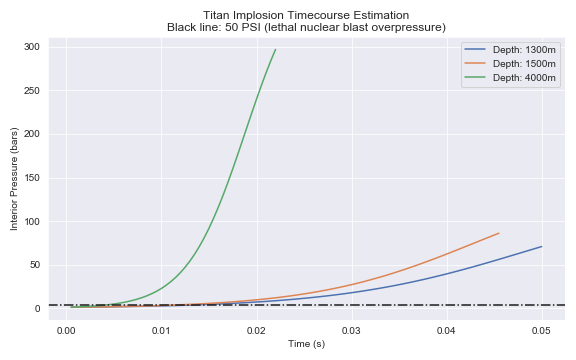How Fast Is Implosion?
Given the attention being paid to the OceanGate Titan submersible loss, one item in the news was an interview with the aunt of the 19-year-old tourist who died in the incident. She said that the news of its likely loss due to implosion was a better ending, because it meant her nephew had not suffered death from hypoxia or hypothermia.
And that brought me to the question, just how fast is such an implosion?
There are a few ways to get a handle on that.
One would be to get a billionaire to fund building multiple ‘Titan’ class submersibles, and keep cycling them and some data loggers down to 4000m depth and back until they, too, implode, and get the data from the data loggers.
Another would be to utilize calculus or partial derivatives to model the essentials of such an implosion. That should get pretty close to a precise figure.
And another, sloppier way, is to apply a piece-wise incremental analysis. I’m going to talk about this approach, because that is what I did.
In this approach, I’m making a large number of simplifying assumptions. I will discuss them and their likely effect on results.
The Wikipedia article on the incident also gives some info on the Titan submersible. The primary data I took from that were the length of the carbon-fiber tube and the internal diameter of the tube (2.4m long, 1.42m diameter).
I further assume that internal pressure was kept at one atmosphere (1 bar or 101325.0 Pa).
My simple model of implosion is that the carbon-fiber tube lost integrity, and so what I calculated treats the tube as a zero-thickness mass that separates the high external pressure from the low internal pressure, and treats whatever volume exists in the end caps as not being relevant to the implosion calculation. I start at time 0.0s with the initial state of the full volume of the cylinder at 1 bar and 25.0 degrees C, and the external pressure at some figure corresponding to a depth of interest. Then I advance by a timestep of 0.0005s, calculating the acceleration of a mass corresponding to the tube (which I don’t know and haven’t seen a figure for, so I am guessing a figure of 1000kg) given the net pressure difference between inside and outside. Applying the instantaneous acceleration, I can calculate how far the tube wall moves inward in the timestep. That induces a change in pressure in the interior gas and a change in temperature. Those values are used to set the new interior pressure and temperature values. The process iterates until the distance the wall moves in falls below a threshold value (I am ignoring momentum entirely), which I take as 0.001m (1 millimeter), which happens because my simple model actually keeps the cylinder intact, it just allows the diameter to decrease until exterior and interior pressure are coming into balance. Virtually all of these choices are conservative, that is, they will result in a longer time course for ‘implosion’ than what likely actually holds.
This graph shows the estimated time course for three depths: 1300m, 1500m, and 4000m. It plots the interior pressure as the implosion happens, given the conditions I stated above. There’s a black line added for the 50 PSI value that is considered a lethal pressure for those in proximity to an explosion, say from a nuclear bomb. That pressure is exceeded in about 5ms in the 4000m case, and in under 20ms in the 1300m and 1500m cases.
A recent podcast I overheard said that humans live about 400 to 500ms in the past. If that holds, all of these estimated timecourses of implosion are far shorter. Given that the remnants of the pressure hull would quickly be accelerated to velocities comparable to bullets, I think we can credit that the neural circuitry in the brains of the passengers was reduced to a non-cognitive state fast enough that the aunt mentioned early in this post can rest easy that her nephew likely did not feel a thing.
